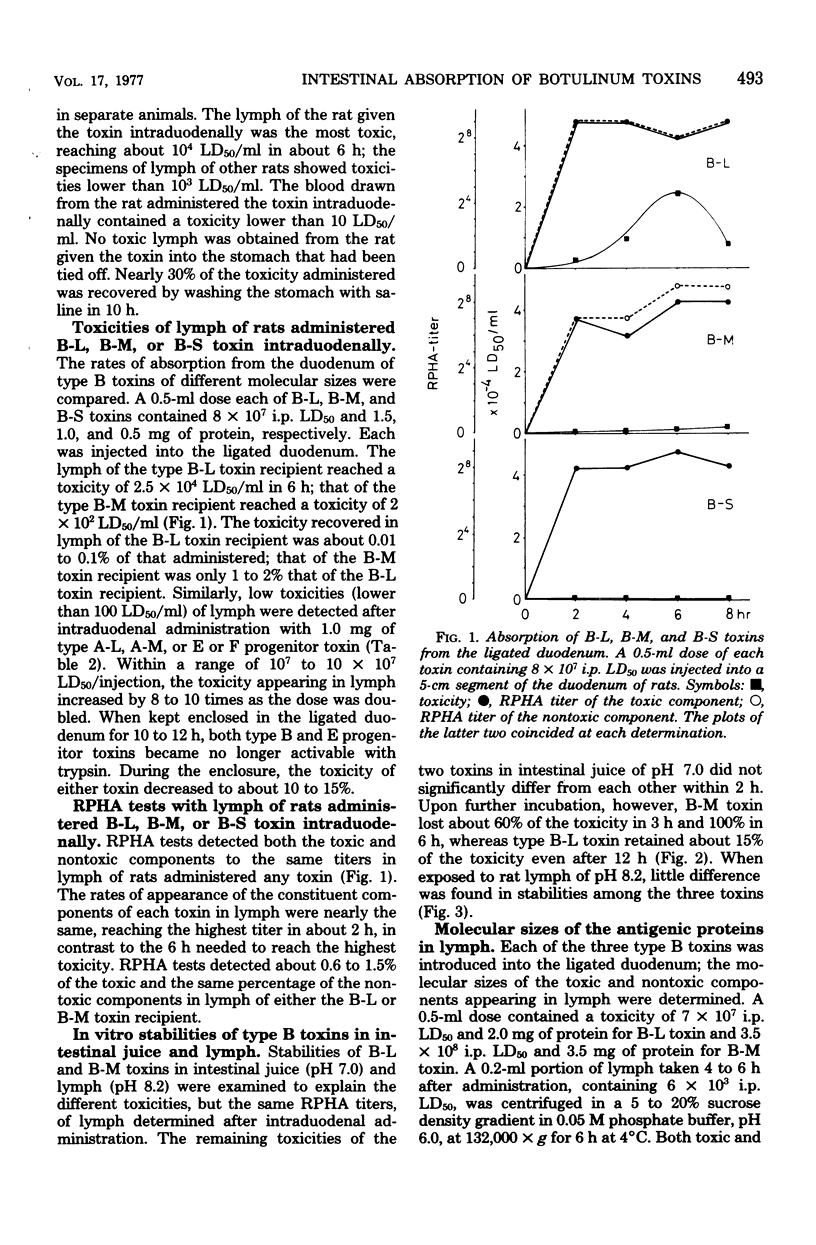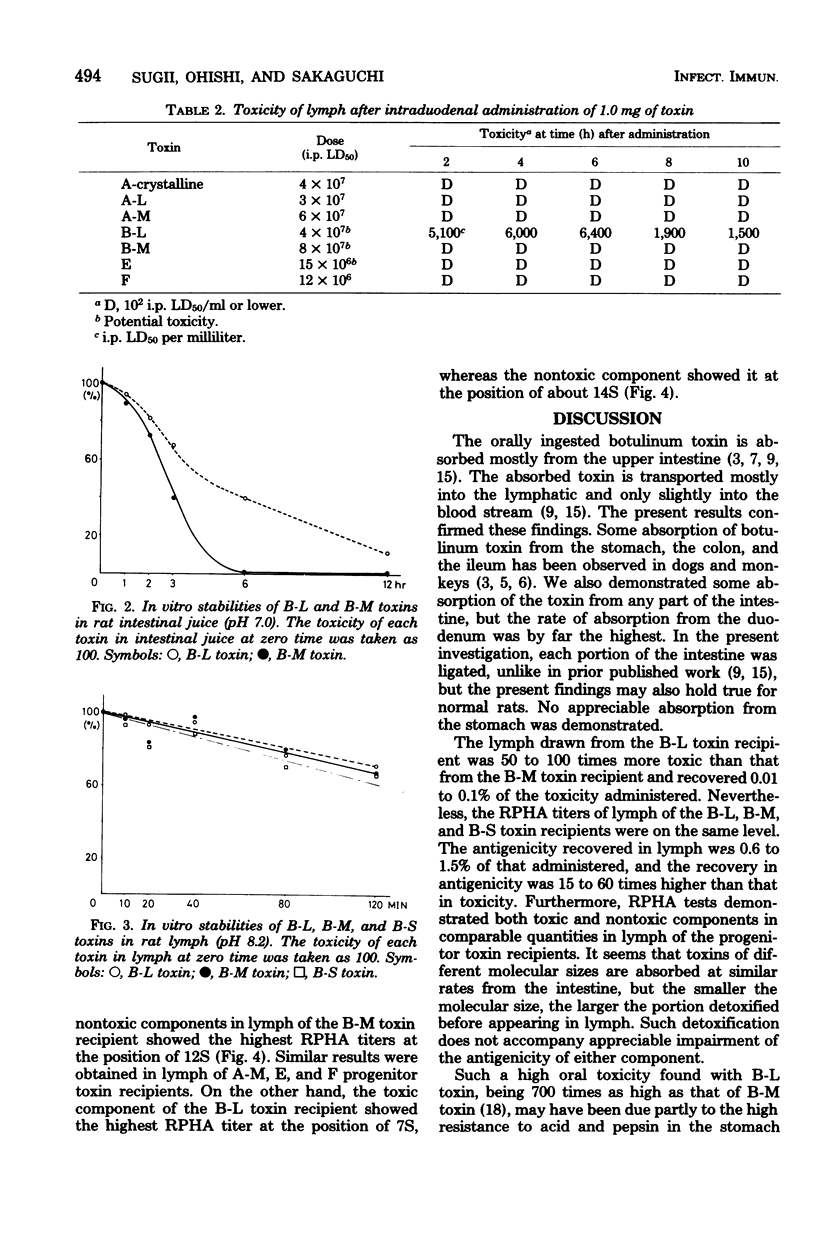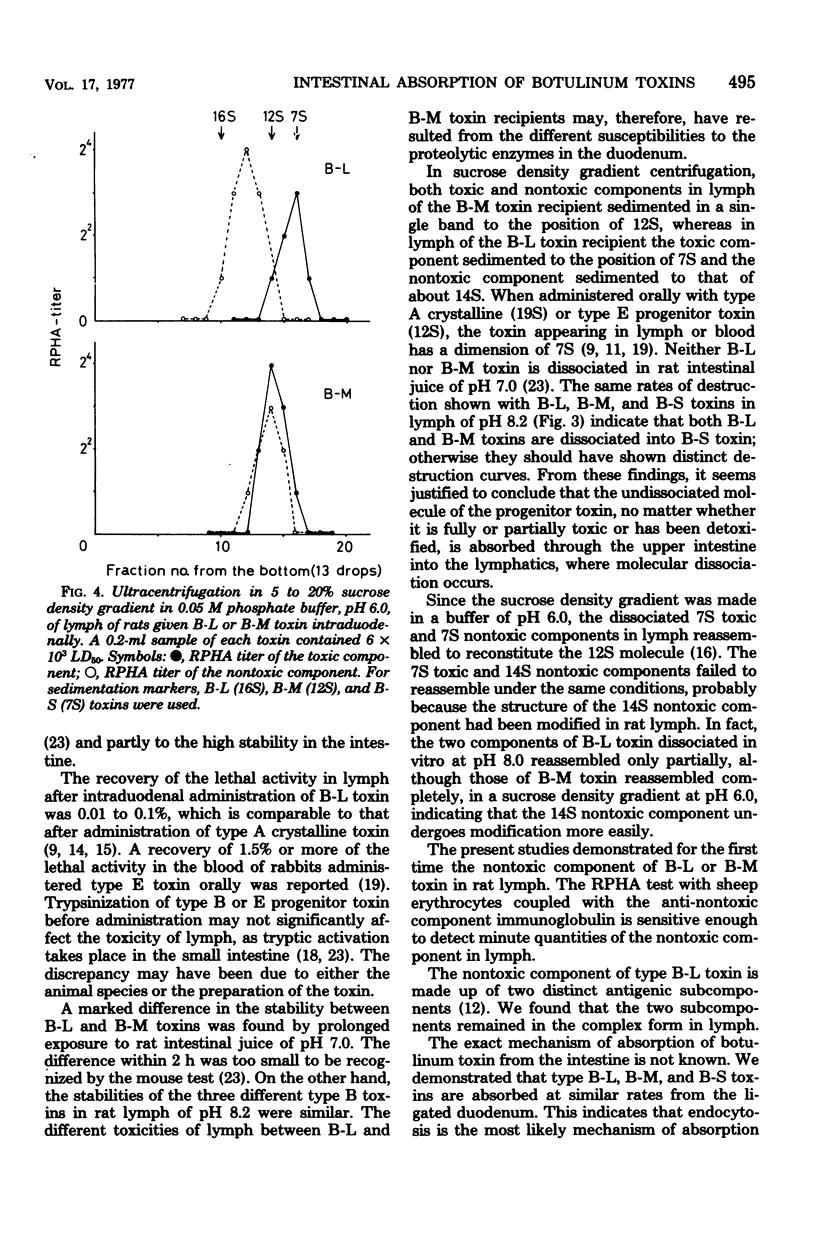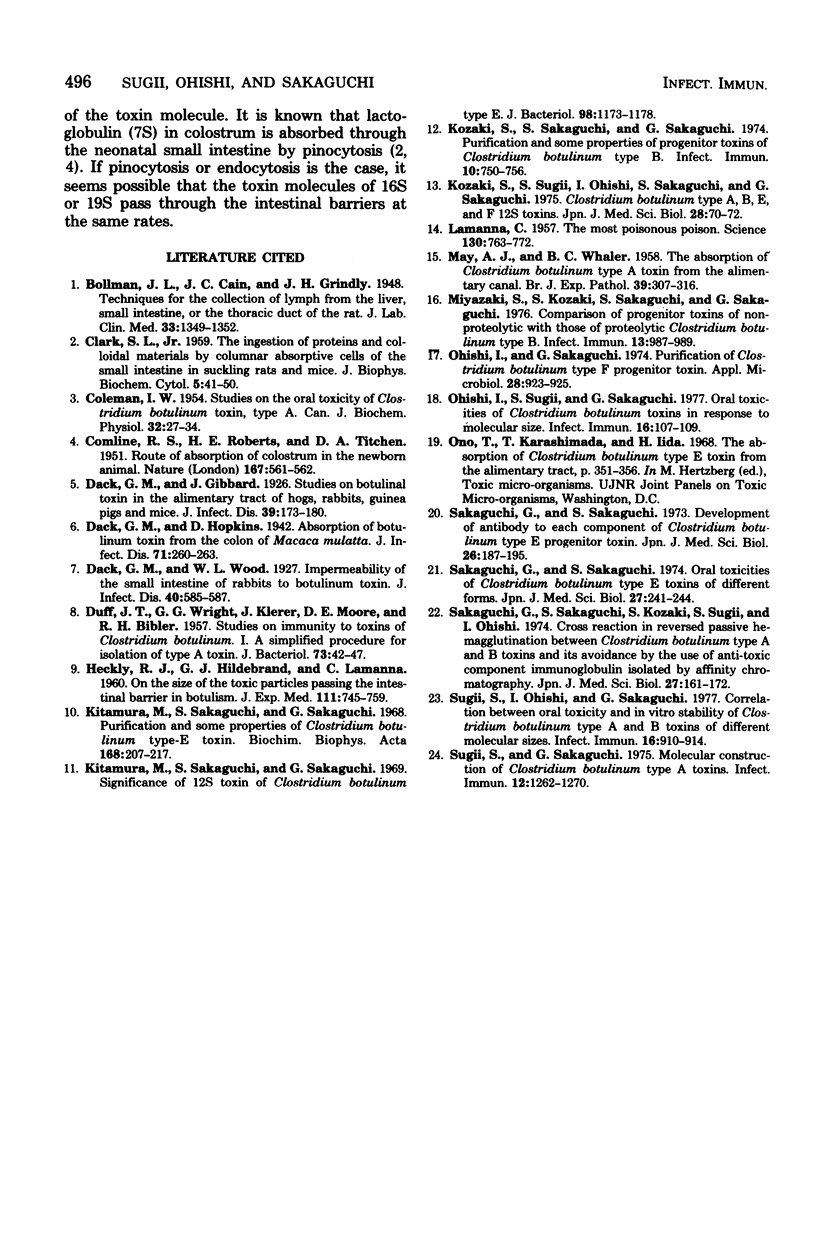Abstract
During a period of 10 to 12 h after injection of type B 16S (L) toxin into the ligated duodenum of rats, 0.01 to 0.1% of the total toxicity administered was found in the lymph drawn by cannulation of the thoracic duct. The recovery was 50 to 100 times higher than that of the rat given type B 12S (M) or 7S (S) toxin. During the same period, 0.6 to 1.5% of the specific antigens were recovered, regardless of the molecular size of the toxin that had been administered. In lymph of the B-L or B-M toxin recipient, the toxic and nontoxic components were detected in comparable quantities, indicating that the undissociated progenitor toxin molecule is absorbed through the intestinal wall. Although the toxic component had lost its toxic activity, the two components of B-M toxin appearing in lymph reassembled to reconstruct the 12S molecule, whereas those of B-L toxin did not, although the toxic component was still active. Type B-L, B-M, and B-S toxins showed similar stabilities to in vitro exposure to rat lymph (pH 8.2), but B-L toxin showed a considerably higher stability to intestinal juice (pH 7.0) than did B-M toxin. Thus, the toxicity of lymph of rats administered botulinum toxin intraduodenally depends not upon the rate of absorption, but largely upon the stability in the intestine.
Full text
PDF





Selected References
These references are in PubMed. This may not be the complete list of references from this article.
- CLARK S. L., Jr The ingestion of proteins and colloidal materials by columnar absorptive cells of the small intestine in suckling rats and mice. J Biophys Biochem Cytol. 1959 Jan 25;5(1):41–50. doi: 10.1083/jcb.5.1.41. [DOI] [PMC free article] [PubMed] [Google Scholar]
- COLEMAN I. W. Studies on the oral toxicity of Clostridium botulinum toxin, type A. Can J Biochem Physiol. 1954 Jan;32(1):27–34. [PubMed] [Google Scholar]
- COMLINE R. S., ROBERTS H. E., TITCHEN D. A. Route of absorption of colostrum globulin in the newborn animal. Nature. 1951 Apr 7;167(4249):561–562. doi: 10.1038/167561a0. [DOI] [PubMed] [Google Scholar]
- DUFF J. T., WRIGHT G. G., KLERER J., MOORE D. E., BIBLER R. H. Studies on immunity to toxins of Clostridium botulinum. I. A simplified procedure for isolation of type A toxin. J Bacteriol. 1957 Jan;73(1):42–47. doi: 10.1128/jb.73.1.42-47.1957. [DOI] [PMC free article] [PubMed] [Google Scholar]
- HECKLY R. J., HILDEBRAND G. J., LAMANNA C. On the size of the toxic particle passing the intestinal barrier in botulism. J Exp Med. 1960 Jun 1;111:745–759. doi: 10.1084/jem.111.6.745. [DOI] [PMC free article] [PubMed] [Google Scholar]
- Kitamura M., Sakaguchi S., Sakaguchi G. Purification and some properties of Clostridium botulinum type-E toxin. Biochim Biophys Acta. 1968 Oct 21;168(2):207–217. doi: 10.1016/0005-2795(68)90144-x. [DOI] [PubMed] [Google Scholar]
- Kitamura M., Sakaguchi S., Sakaguchi G. Significance of 12S toxin of Clostridium botulinum type E. J Bacteriol. 1969 Jun;98(3):1173–1178. doi: 10.1128/jb.98.3.1173-1178.1969. [DOI] [PMC free article] [PubMed] [Google Scholar]
- Kozaki S., Sakaguchi S., Sakaguchi G. Purification and some properties of progenitor toxins of Clostridium botulinum type B. Infect Immun. 1974 Oct;10(4):750–756. doi: 10.1128/iai.10.4.750-756.1974. [DOI] [PMC free article] [PubMed] [Google Scholar]
- Kozaki S., Sugii S., Oishi I., Sakaguchi S., Sakaguchi G. Proceedings: Clostridium botulinum type A, B, E and F 12S toxins. Jpn J Med Sci Biol. 1975 Feb;28(1):70–72. [PubMed] [Google Scholar]
- LAMANNA C. The most poisonous poison. Science. 1959 Sep 25;130(3378):763–772. doi: 10.1126/science.130.3378.763. [DOI] [PubMed] [Google Scholar]
- MAY A. J., WHALER B. C. The absorption of Clostridium botulinum type A toxin from the alimentary canal. Br J Exp Pathol. 1958 Jun;39(3):307–316. [PMC free article] [PubMed] [Google Scholar]
- Miyazaki S., Kozaki S., Sakaguchi S., Sakaguchi G. Comparison of progenitor toxins of nonproteolytic with those of proteolytic Clostridium botulinum Type B. Infect Immun. 1976 Mar;13(3):987–989. doi: 10.1128/iai.13.3.987-989.1976. [DOI] [PMC free article] [PubMed] [Google Scholar]
- Ohishi I., Sugii S., Sakaguchi G. Oral toxicities of Clostridium botulinum toxins in response to molecular size. Infect Immun. 1977 Apr;16(1):107–109. doi: 10.1128/iai.16.1.107-109.1977. [DOI] [PMC free article] [PubMed] [Google Scholar]
- Oishi I., Sakaguchi G. Purification of Clostridium botuliunum type F progenitor toxin. Appl Microbiol. 1974 Dec;28(6):923–928. doi: 10.1128/am.28.6.923-928.1974. [DOI] [PMC free article] [PubMed] [Google Scholar]
- Sakaguchi G., Sakaguchi S. Development of antibody to each component of Clostridium botulinum type E progenitor toxin. Jpn J Med Sci Biol. 1973 Dec;26(5):187–195. doi: 10.7883/yoken1952.26.187. [DOI] [PubMed] [Google Scholar]
- Sakaguchi G., Sakaguchi S., Kozaki S., Sugii S., Oishi I. Cross reaction in reversed passive hemagglutination between Clostridium botulinum type A and B toxins and its avoidance by the sue of anti-toxic component immunoglobulin isolated by affinity chromatography. Jpn J Med Sci Biol. 1974 Jun;27(3):161–172. doi: 10.7883/yoken1952.27.161. [DOI] [PubMed] [Google Scholar]
- Sakaguchi G., Sakaguchi S. Oral toxicities of Clostridium botulinum type E toxins of different forms. Jpn J Med Sci Biol. 1974 Aug;27(4):241–244. doi: 10.7883/yoken1952.27.241. [DOI] [PubMed] [Google Scholar]
- Sugii S., Ohishi I., Sakaguchi G. Correlation between oral toxicity and in vitro stability of Clostridium botulinum type A and B toxins of different molecular sizes. Infect Immun. 1977 Jun;16(3):910–914. doi: 10.1128/iai.16.3.910-914.1977. [DOI] [PMC free article] [PubMed] [Google Scholar]
- Sugii S., Sakaguchi G. Molecular construction of Clostridium botulinum type A toxins. Infect Immun. 1975 Dec;12(6):1262–1270. doi: 10.1128/iai.12.6.1262-1270.1975. [DOI] [PMC free article] [PubMed] [Google Scholar]


